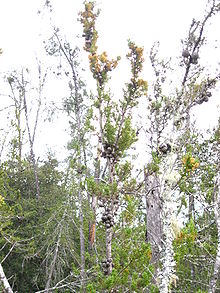Cupressus abramsiana
| Cupressus abramsiana | |
|---|---|
 |
|
| Santa Cruz Cypress showing stunted growth due to nutrient and moisture-poor sandstone substrate at Majors Creek, Santa Cruz Co. Ca. | |
| Scientific classification | |
| Kingdom: | Plantae |
| Division: | Pinophyta |
| Class: | Pinopsida |
| Order: | Pinales |
| Family: | Cupressaceae |
| Genus: | Cupressus |
| Species: | C. abramsiana |
| Binomial name | |
|
Cupressus abramsiana C.B.Wolf 1948 |
|
 |
|
| Natural range of Cupressus abramsiana | |
| Synonyms | |
|
Synonymy
|
|
Cupressus abramsiana (Santa Cruz cypress) is a rare North American species of trees in the cypress family. It is endemic to the Santa Cruz Mountains of Santa Cruz and San Mateo Counties in west-central California.
When cypresses were discovered in the Santa Cruz Mountains in 1881, they were first identified as Cupressus goveniana, but Jepson (1909) considered them to be Cupressus sargentii. In a detailed analysis, Wolf (1948) concluded it was a distinct species, naming it after L. R. Abrams, Emeritus Professor of Botany at Stanford University.
Subsequent authors have either followed Wolf in treating it as a species (Griffin & Critchfield 1976, the 1993 edition of the Jepson Manual, and Lanner 1999), or within Cupressus goveniana as either a variety (Cupressus goveniana var. abramsiana (C.B.Wolf) Little; as in Little (1970), the Gymnosperm Database and Farjon (2005)), or not distinguished at all within C. goveniana (Flora of North America)
Santa Cruz cypress is a small evergreen tree growing to 10 meters (33 feet) (rarely to 25 meters or over 83 feet) tall. The bark is gray, with a fibrous stringy texture, shredding on old trees. The foliage is bright green to yellowish-green, with scale-like leaves 1-1.5 mm long, the leaf tips slightly spreading on vigorous shoots but not on small shoots. Seedlings bear needle-like leaves 8-10 mm long. The cones are ovoid, 20-30 mm long and 15-22 mm broad, with eight or ten scales arranged in opposite decussate pairs, with the bract visible as no more than a small lump or short spine on the scale. The seeds are 3-5 mm long, glaucous brown, with a pair of small wings along the sides. The cones remain closed on the trees for many years, until the trees are killed by a forest fire; after the tree is dead, the cones open to release the seeds which can then germinate successfully on the bare fire-cleared ground.
...
Wikipedia

